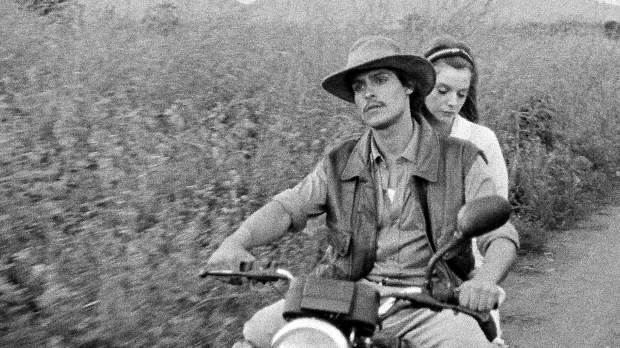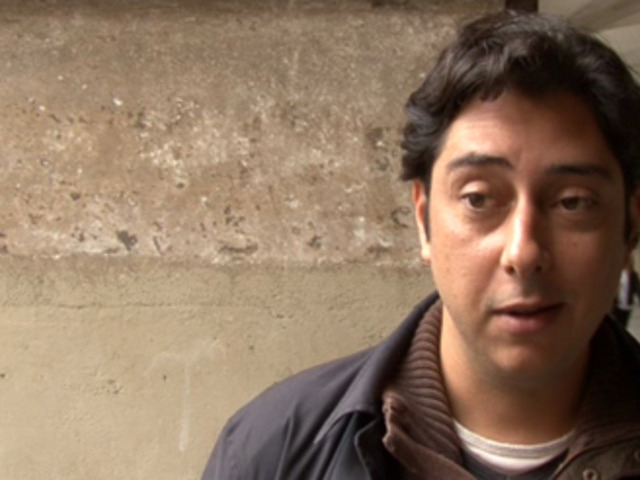 Back to selection
Back to selection
The Pact: Miguel Gomes on Cinema and Tabu

Part realism and part fantasy, half 35mm and half 16mm, part post-colonial and part colonial, half a swooning love story and half a clear-eyed political assessment, Miguel Gomes’s Tabu functions, as he puts it in this interview, within a structure of oppositions. Simultaneously a rebuke – and vindication – of the concept that “the personal is the political,” Tabu is a carefully constructed film in two halves, each of which comments upon the absences articulated in the other.
We start in present-day Portugal, with Pilar (Teresa Madruga), a middle-aged woman who works for an unidentified lefty non-profit. Pilar is of good conscience but quite lonely, a non-romance with a painter whom she finds annoying the only thing we see as occurring in her love life. Without children, she spends some time checking in on her next-door neighbor, an elderly woman named Aurora (Laura Soveral) who is constantly accusing her nurse, Santa (Isabel Cardoso) of performing witchcraft upon her. Aurora doesn’t play a central role in the film’s first half until its end, when her health takes a turn for the worse and Pilar has to track down an old man she once knew, Ventura (Henrique Espirito Santo). This leads to the film’s second half, a dialogue-less romanticized affair that revolves around the romance between young Aurora (Ana Moreira) and young Ventura (Carlo Cotta) 50 years earlier in colonial Africa. As romantic and fantastic as the first half is even and realistic, this second half is a real feat of filmmaking, with Gomes using the full power of an older, now-romanticized kind of style (think Murnau, from whose 1931 film the title is taken) to serve a thoroughly modern end. I had the chance to Skype recently with Gomes, who, it must be said, smoked cigarettes during our interview with the casual air of a young Jean-Luc Godard.
Filmmaker: I wanted to ask you about cinema as a formal system. Why is cinema so uniquely suited to expressing memory, articulating memory?
Gomes: You start with a very complicated question, huh? I don’t know – cinema has this great quality of providing us with memories, memories of things that existed, that have existed, like looking at dead people, dead actors, seeing films made from the end of the 19th century to today. But at the same time, it provides us with false memories. They are memories of fiction. For instance, this Africa you get to see in Tabu, this Africa becomes truer – this false memory cinema provided us – because I was never in Africa before. My memory of Africa is Tarzan, it’s Hatari!, it’s Out of Africa. This is something we share, cinema is able to do this – it’s able to provide us with these memories of real things and things that never existed.
Filmmaker: And isn’t the creation of a past that never existed, in a way, an attempt to compensate for or erase a more painful past, like a colonial past?
Gomes: In the second part of the film, I think the characters are completely unaware of what’s happening – socially, politically – because they’re engaged in playing films. Maybe they are playing Out of Africa in a very dysfunctional way. They are singing love songs. They seem completely unaware of what’s coming – the colonial empire is going to fall apart. I’ve dealt with this question of colonialism in this way. They didn’t see anything coming.
Filmmaker: So is cinema both a flight from the real world even while, at its best, it enables us to reconnect with the real world?
Gomes: It’s a strange mix of things. The only cinema that’s interesting is cinema that has a bond with reality. But most of the arthouse European films today are engaged in a realistic approach to the world. And I think that cinema will always lose if it’s just trying to imitate reality. Reality is more real than cinema. Cinema is another thing – it’s cinema. It must have a bond with reality, but it must have different rules than reality. With Tabu, for instance, there are some people – I don’t know if I agree with them – but some people say I’m doing a very strange remake of The Wizard of Oz. The Wizard of Oz has two parts, Dorothy is in Kansas, and then she goes to Oz, and Oz is cinema. But I think Kansas is odd too. It’s not real life, but it has a connection with it.

Filmmaker: The second half of your film works with the medium in a very direct sense. It reminded me of Alain Resnais and Chris Marker, to a degree. You mention that a lot of international art cinema is based in realism today. There’s not as much formal play with the abilities of the medium as there was, say, during the 1960s. Do you have any thoughts on why the dominant trend in art cinema has moved toward realism over the course of the last 50 years?
Gomes: It’s difficult for myself to answer for my own work, so I’m completely unable to speak for the others. I think that it was the answer of European cinema to mainstream American cinema. I think their answer was to make more realistic films, characters that don’t normally appear in films. I think the model is the Dardenne brothers. I’ve been working as a teacher – not teaching that much, because I don’t know how to do it – but I’ve been teaching students trying to make short films. It’s obvious their model is the Dardenne brothers, they like this realism. We talk about if their work is “real enough.” It’s difficult for me to have those conversations with them, because I say no, just go see The Wizard of Oz, see Murnau. Murnau is very distant from reality, but it’s one of the high points of German cinema.
Filmmaker: To go back to Tabu – I thought the choice to enter the film through Pilar was an interesting one. Did you construct Pilar from the start, or after the film’s initial conception?
Gomes: We had Pilar from the beginning. We knew Aurora would reappear in the second part, but I wanted Pilar to be the main character of the first section. The film functions in oppositions, and I wanted a character in the first half who was very aware of things, aware that the world is not the most fair and good place. Pilar is very aware of the societal guilt, she’s the kind of character who wants to deal with this guilt, even in a naïve way. Then, in the second part we have a main character who seems completely unaware of everything – of the regime, of what’s surrounding her socially. We wanted to have these two opposite characters. It’s almost like we start with the hangover – Pilar is the hangover of Aurora, and then when we get to Aurora, we already know that Aurora’s dead, that the empire will fall, so we have the drinking part after we see the hangover.
Filmmaker: What’s also interesting is that Aurora’s ignorance regarding her surroundings is sort of inverted with Pilar’s awareness – Aurora being able to focus on her romance, while Pilar ignores a potential romance.
Gomes: Pilar is a very good soul, too much, I think, but even she has limits. This painter is really a pain in the ass for her – he makes bad paintings and he’s boring. There are these two different love stories, but they come in the context of opposition between two ages – the post-colonial society in Portugal and the colonial society in Africa. Also, two different ages from the perspective of the age of a person – we have older characters in the first half than in the second.
Filmmaker: There’s something interesting in your earlier comment about cinema having trouble doing realism, and it makes me think of your decision to omit dialogue in the second half of the film. In a way, doesn’t dialogue inhibit cinema from achieving its full potential, as far as creating a cinematic space of its own?
Gomes: Of course you’re right, but I think it’s not a question of having to eliminate dialogue. This film has a very strong connection with memories, false memories – we don’t know if Ventura is making the story up, he looks a little crazy too, talking about extinct animals that his friend captured. There are details in the story – I can’t vouch entirely for Ventura’s storytelling. But even if it’s a fictional memory, yes, I wanted to have a dreamlike quality that dialogue would have made more real. I wanted to make the second half feel like something that is long gone, something that is not reality, something else.
Filmmaker: Yes, and capturing the animal was an interesting sequence – where Ventura’s friend, we are told, captures an exotic animal, and we see the cage for it, but we never see this mythical creature itself.
Gomes: When we make a film, we are proposing a pact between the film and the viewer. The pact goes like this: it’s the viewer’s role to accept, to believe in what the film is showing. I think that one of the things that bothers me with realism is, it looks like the director is making a great effort to convince the viewer that what they’re seeing is reality. So then they have to believe it. The opposite is much more interesting – it’s much more interesting if I’m not seeing the animal in the cage, it’s not there, I have to make an effort to accept this, to believe in the unbelievable. That’s the whole beauty of cinema. To believe in the Lion and the Tin Man. There’s a filmmaker in America I like nowadays, Wes Anderson, and in The Royal Tenenbaums, there’s a scene with Gene Hackman, where he goes to see his daughter’s birthday and she does a play with her siblings. Someone asks Royal Tenenbaum, what did you think of the play? And he says, “Well, it’s only a bunch of kids wearing animal suits.” So he didn’t believe. Cinema is just a bunch of kids dressed in animal suits. You have to decide if you believe in this, if you accept the pact, which is a pact of belief.
